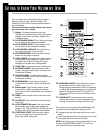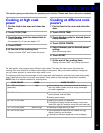
Before you begin operating the oven, carefully read the following instructions.
Installation Instructions
5
1. Empty the microwave oven. Clean the inside with
a soft, damp cloth. Check for damage such as a
door that isn’t lined up correctly, damage around
the door, or dents inside the oven or on the exteri-
or. If there is any damage, do not operate the oven
until a designated service technician has checked
it and made any needed repairs.
2. Put the oven on a cart, counter, table, or shelf that
is strong enough to hold the oven and the food and
utensils you put in it. (The control side of the unit
is the heavy side. Use care when handling the
oven.) The weight of the oven is about 55 lbs
(25 kg). The microwave oven should be at a
temperature above 50°F (10°C) for proper operation.
NOTE: You can build your microwave oven into a
wall or cabinet by using one of the trim kits listed in
the “Built-in kits” section.
NOTE: Do not block the exhaust vents or air intake
openings. Allow a few inches of space at the back of
the oven where the exhaust vents are located.
Blocking the exhaust vents could cause damage to
the oven and poor cooking results. Make sure the
microwave oven legs are in place to ensure proper
airflow. If vents are blocked, a sensitive thermal safe-
ty device may automatically turn the oven off. The
oven should work properly once it has cooled.
wWARNING
Fire Hazard
Do not install the oven next to or over a heat
source without a UL approved trim kit.
Doing so can result in death, fire,
or electrical shock.
Observe all governing codes and ordinances. A 120
Volt, 60 Hz, AC only, 15- or 20-amp fused electrical
supply is required. (A time-delay fuse is
recommended.) It is recommended that a separate
circuit serving only this appliance be provided.
wWARNING
Electrical Shock Hazard
Plug into a grounded 3 prong outlet.
Do not remove ground prong.
Do not use an adapter.
Do not use an extension cord.
Failure to follow these instructions can
result in death, fire, or electrical shock.
ELECTRICAL REQUIREMENTS
Air intake
opening
(in rear)
Power
supply cord
Exhaust vent
(in rear)


















